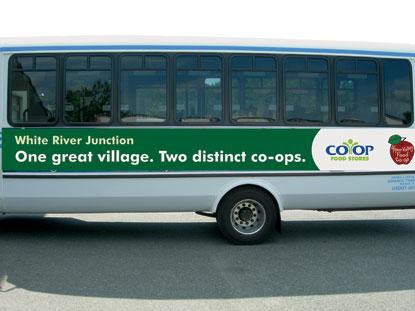One Town, Two Co-ops

White River Junction is a small town at the confluence of the White and Connecticut Rivers in central Vermont. For the past 35 years, it has been the home of the Upper Valley Food Co-op. The town also had a conventional grocery store that operated under several banners, Grand Union and P&C Supermarkets being the latest.
In late 2009, the parent company of the P&C store declared bankruptcy and announced the sale or closing of all its stores, leaving the town without a conventional grocery. Soon after the announcement of the closing of the White River Junction store, the Hanover Co-op was approached by the building's owner to consider leasing the space and opening a co-op store.
Hanover Co-op, in its 75th year, already was operating two full-size supermarkets in Hanover and Lebanon, N.H. White River Junction is seven miles from Hanover, needed a store that fit the profile of our current stores, and was home to many Hanover Co-op members. While there was good reason to open a store, there was also a concern that it not intrude on the market for Upper Valley Food Co-op.
By the time the opportunity for a White River Junction store surfaced, and key to this story, Hanover and Upper Valley had been working together for several years. The two co-ops collaborated first through involvement in the Cooperative Grocers Association of the Northeast and then through the National Cooperative Grocers Association and the Neighboring Food Co-op Association (NFCA).
Through the NFCA, Upper Valley General Manager Kye Cochran, board member/staff person Sharon Mueller, and I had collaborated closely on a scenario-development process with Eric DeLuca (then with NFCA). Through that process, we built both a strong working relationship and a respect for each other's contributions in a rewarding project. So, when Hanover got the opportunity to operate in White River Junction, I called Cochran to discuss her feelings about it. While she expressed some concern about Hanover opening a store so close to hers (less than a mile away), she immediately voiced confidence that we could find a way to collaborate to make it work for both co-ops.
A first step in the process was to get together a meeting of management and board representatives of the two organizations. At that meeting, several concerns were raised and fears surfaced. We spoke together not only about our mutual desire to cooperate for the benefit of each, but also about our concerns for the future of the Upper Valley Co-op. Following that meeting, representatives of the Upper Valley board and management attended a Hanover board meeting to assure the full Hanover board of directors of Upper Valley's support for the move and to express a belief that the two co-ops could -collaborate to support the -success of each other.
Without knowing the exact details of how we would collaborate, but trusting it could happen, Hanover Co-op went ahead with plans for the new store. While designing the product line, Hanover planners decided not to use limited space for bulk foods and a natural HABA section, reasoning that those products could be better handled by Upper Valley. In addition, it was decided that the organic produce section would carry limited variety in the White River store for the same reason. Signs were designed to indicate to Hanover's White River Junction shoppers that those products were available nearby at the Upper Valley Co-op.
At the time of the opening of Hanover's White River store, we started a "one town, two co-ops" campaign. These advertisements ran in the local paper, and the theme was featured in radio spots and some outdoor advertising. This fall, the ads will appear on buses for the local transit system.
On the governance level, both Hanover and Upper Valley boards saw an opportunity to ensure cooperative collaboration. They wrote drafts of executive limitation and board governance policies and discussed adopting them. They are now in the final phase of adoption of policies calling for joint cooperation.
After more than one year of this experiment, the results have been mixed. Upper Valley Co-op did experience a dip in sales since the opening of the White River Junction store. However, management has done an excellent job in controlling expenses, and the major financial indicators (including net earnings) are strong. Meanwhile, Hanover's new White River Junction store continues to build sales, and the combined co-op stores' share in the local economy continues to grow. ν







